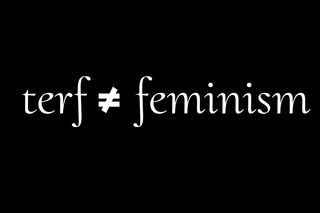
Feminism That Excludes Trans Women Is Bigoted, Not Radical
TERFs (Trans Exclusionary Radical Feminists) believe trans women want to replace them; trans women just want the right to be women.

Germaine Greer, an Australian writer, academic and a major voice in the second-wave feminist movement, once said, “I’m not saying that people should not be allowed to go through that [sex-change] procedure, all I’m saying is that it doesn’t make them a woman.”
That this statement is transphobic is obvious. However, there does exist a section of women — feminists, even — who do not believe that transphobia is wrong. Trans Exclusionary Radical Feminism (TERF) rests on the belief that trans women are not women — or are, at best, misogynistic caricatures of women. Sometimes, TERF-ism also manifests as ‘gender critical’ feminism, which holds that gender is societal conditioning and that women, as a biological class, are oppressed by men, as a biological class.
The beginning of the conflict between trans people and trans-exclusionary radical feminists can be traced back to the 1970s, and was at its peak when Janice Raymond published the then acclaimed book, The Transsexual Empire, in which she wrote, “All transsexuals rape women’s bodies by reducing the real female form to an artifact, appropriating this body for themselves.… Transsexuals merely cut off the most obvious means of invading women, so that they seem non-invasive.” The term ‘TERF’ was first written on the Internet by writer Viv Smythe and used orally by multiple cis and trans activists before her.
If there was a checklist for what makes an individual a woman, it would fail spectacularly. Not all women have the exact same biological functions — some don’t menstruate, some can’t birth children, some don’t have breasts. If it is lived experience, then that fails, too; there does exist a section of women who don’t undergo sexual harassment and discrimination. What unifies women, perhaps, is only that they believe they are women and want to live their lives as women.
“Any attempt to catalog the commonalities among women … has the inescapable result that there is some correct way to be a woman. This will inevitably encourage and legitimize certain experiences of gender and discourage and delegitimize others, subtly reinforcing and entrenching precisely those forces of socialization of which feminists claim to be critical. And what’s worse, it will inevitably leave some people out. It will mean that there are ‘real’ women whom feminism should be concerned about and that there are impostors who do not qualify for feminist political representation,” writes Carol Hay for The New York Times.
Related on The Swaddle:
Corporate India Needs to Get With the Program — Trans Inclusion Is Good for Business
While third-wave feminism is deeply influenced by intersectionality and has mostly been pro-trans rights, multiple second-wave feminists — including influential voices like Greer and Raymond — continue to hold trans-exclusionary beliefs. However, a large number of TERF issues of concern — trans women being allowed into women’s/gender-neutral washrooms, trans women identifying as women, trans women riding a trend, a cult, a fetish — are focused on trans women (women who were assigned male biologically and societally at birth) and rarely on trans men (men who were assigned female biologically and societally at birth).
Lucian Clark, who created GenderTerror, a site that educates people about the intersection of identity, gender, sexuality, and horror, believes that TERF-ism is actually rooted in transmisogyny. They write, “People say radical feminists and TERFs are trans*phobic when in reality, most of their problems rest with trans women. These people are inherently transmisogynistic. Their problem does not encompass trans men. They believe that penises are inherently oppressive and that people need to be socialized as a gender in order to actually be that gender. They are biological essentialists while also calling for the abolition of stereotypes, patriarchy, and other institutions that rely on the very biological essentialism they believe in.”
The heart of TERF transmisogyny is seeing trans women as ‘imposters.’ Trans women know they are women within and that they need to live as women to achieve mental stability. But, TERFs believe trans women want to speak over or replace cisgender women with themselves. TERFs also believe that trans women play up the ideal standard of femininity to come across as ‘better’ than cisgender women.
This is absurd because trans women spend a superhuman amount of time, money and effort to dress, behave and pass as cisgender women to reduce the terrible dysphoria that comes with living in a body that doesn’t match their consciousness. The goal for trans women has always been to live as cisgender women do, without any uninvited outside concern, opinion or bigoted behavior regarding their gender identity; they are not trying to one-up or ‘replace’ women. Trans women also pay a great price for living their truth, coping with extreme violence and hatred, but always have remained and continue to remain at the forefront of intersectional resistance against bigotry.
The need to gatekeep trans women from being who they are intrinsically is nothing but bigotry. Trans Exclusionary Radical Feminism represents the complete opposite of intersectional feminism, which is complex and covers so many other cultures and sexualities in its fight to end discrimination. No feminism that excludes the marginalized is intersectional, and any feminism that isn’t intersectional is invalid. TERFs need to understand a simple truth: all trans women are women, period.
Aditi Murti is a culture writer at The Swaddle. Previously, she worked as a freelance journalist focused on gender and cities. Find her on social media @aditimurti.
Related


New Voices in the Indian Comedy Scene Might Break Its Reliance on Stereotypes
